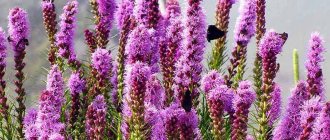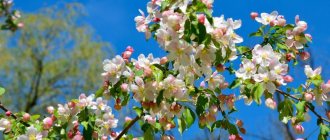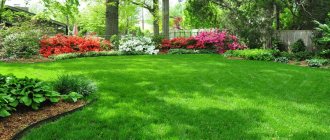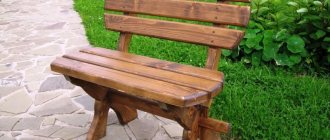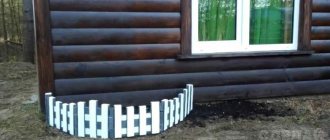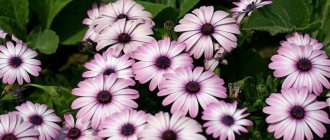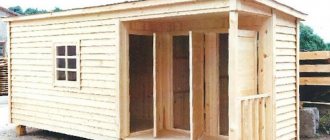A well-groomed dacha plot will be decorated with a green fence, masking unsightly buildings, framing the paths. A good solution for zoning an area would be a hedge made from bladderwort, an unpretentious shrub that lends itself well to pruning. The plant grows well in temperate latitudes and forms a dense crown that changes color in the fall. A green fence creates additional protection from street dust and the noise of passing cars.
The shrub owes its name to the characteristic shape of its fruits.
Bladderwort in landscape design - a thick and beautiful fence
The luxurious vesicular carp, a deciduous shrub, looks very attractive in group plantings. Plantings with patterned leaf plates will decorate any landscape, emphasize the beauty of flower beds and coniferous plants, become a successful enclosure for a farmstead, barbecue or recreation area, and separate from the garden without violating the unified style of landscape design.
Bladderwort can be planted next to other ornamental shrubs
The shrub is highly decorative from the second half of spring to late autumn. The vesicular carp blooms from June to the end of August; small white or pale pink flowers form hemispherical caps of inflorescences. The dark green fruit boxes have a pleasant burgundy or cherry hue. Leaves turning yellow or red are especially beautiful against the backdrop of a dull autumn landscape.
Incredibly beautiful inflorescences with a pleasant aroma leave no one indifferent
Bladderwort in landscape design is good in mono-planting and two-stage hedges using tall and low-growing varieties. The bushes are planted at a short distance from each other, the bottom row compensates for the basal sparseness of tall plants, resulting in a dense two-stage hedge along the entire height.
Two-tiered hedge with bladderwort in the background
Monochromatic hedges made from varieties with colored leaf plates on lawns and house facades look very elegant. Texture creates a mixture of several varieties. Golden-green or lemon-colored bladderwort combined with violet or purple varieties makes a beautiful combination. Colored shrubs are planted in parallel in two rows or in a checkerboard pattern, alternating one variety of shrub with another.
An attractive combination of different bladderwort varieties in one hedge
The bushes change color intensity depending on the light and soil moisture. The bright colors will fade and the leaves will become greener in shady areas.
In a shady garden, bladderwort leaves are less decorative
Where can I plant thuja
Evergreen thujas on the site carry a multifunctional load. In winter, the area does not look dull; plants act as landscaping elements. Large-sized plants protect less stress-resistant crops during their growing season from the effects of the north wind and create a living barrier. In thuja design they use:
- as a tapeworm;
- included in mixborders with ornamental and flowering shrubs;
- design rock gardens and rockeries;
- dwarf forms of thuja in linear planting are used to create borders, tall varieties are ideal for hedges;
- form group compositions from conifers;
Important! The main requirement when allocating space for a plant is drainage. Lowlands or wetlands are not suitable for the crop. Waterlogged soil often causes the death of conifers
When distributing on the site, take into account the sufficiency of lighting. Varieties with yellow needles lose their decorativeness and color in the shade
Waterlogged soil often causes the death of conifers. When distributing on the site, take into account the sufficiency of lighting. Varieties with yellow needles lose their decorative effect and color in the shade.
Every design idea has a specific association. Thujas only enhance this perception, giving it a special flavor:
- Planted on both sides of the garden path, they add a formal look to the landscape.
- Large crops distributed in different places on the site, dominating in height over other crops, visually expand the territory and give a sense of freedom.
- Asymmetrical lines, which form flowering plants with a spreading crown, emphasize thujas in a single planting; this type of composition relaxes and sets the mood for rest.
If thujas are planted at the dacha, not combined with other types of crops, the choice of variety and location is based on the main structure. A tall residential building will visually cover up short-growing thujas; here the choice should be in favor of large-sized ones; if the building is rectangular, it is better to purchase thujas of a pyramidal shape.
The color of the needles is selected to match the structure of the walls of the building. Golden thujas will look perfect against a green, blue, or gray background. The green color of the needles will be emphasized by white, pink, beige or yellow walls. If the central building is low and wide, preference is given to low-growing species in the form of a bush.
The main use of thuja was found in ornamental gardening:
- to create a hedge. In a small garden, the height of the structure is no higher than 1 m; it creates a barrier to drafts and protects the plantings from dust. Over a large area, large trees are planted to divide it;
- make compositions in Japanese or English style;
- pyramidal arborvitae are included as the centerpiece of heather gardens.
You can use spherical shrubs, which are given a variety of shapes
Important! You should not place other types of trees of the same size in a small area next to a tall thuja, because
the area will look thickened.
Pros and cons of a bladderwort hedge
The popularity of the crop in decoration is explained by the species characteristics of the plant. From the bladderwort, molded and free-growing types of hedges of various heights are created along the perimeter of the site and inside the garden. The crown quickly recovers after pruning, bushiness of low-growing varieties is stimulated along the entire length of the shoots, and the density of the bush is uniform along the entire length.
The bladderwort does not require special care, so it is ideal for beginners
Breeders from Europe and Russia have bred bushes with yellow and red shades of leaves. The spherical fruits, white or pinkish in color, look very decorative. The crop has good growth rates; shoots grow up to 25 cm during the season. The bush quickly recovers after pruning. Plants are not demanding on soil composition, watering, or fertilizing. Many varieties are resistant to scab and powdery mildew and are not attacked by pests. Bladderwort has good adaptability to different climatic conditions.
The leaves stay on the branches until winter and decorate the plant even when dusted with snow.
There are few disadvantages; the bush does not grow well in alkaline soils and flooded areas. Growing conditions depend on the bush variety. Tall bushes eventually become bare at the bottom, and the trunk becomes visible.
Trimming
When caring for the vesicle, it is necessary to carry out pruning. This operation causes little damage to the shrub, and the effect becomes more than noticeable - thanks to pruning, shrubs can be turned into beautiful shapes, hedges or borders. If this procedure is carried out regularly, the vesicular carp takes on a denser and more compact shape.
- sanitary It is carried out throughout the entire growing season, and its essence is to remove all old, broken branches;
- molding This operation is planned in the fall, when the bush has completely faded. In the first year, young shoots must be cut to half their length. Subsequently, pruning is carried out to no more than 2/3 of the length;
- rejuvenating. This pruning is carried out for shrubs over 5 years old. You can do it in the fall or early spring. To do this, you need to completely cut off the old branches to the ground. All other shoots must be removed to the areas where a side branch begins to form.
If the bladderwort is grown as a hedge, then it should be pruned no more than once or twice a season. This operation is performed for the first time in April before the buds begin to bloom.
Reproduction
The most effective methods of propagating bladderwort are the use of cuttings and transplantation of layering.
Cuttings. First you need to choose a bush that has well-developed side shoots. Next, you need to prepare young branches that have grown this year. They need to be placed in a container containing immunomodulators, for example, rootin or zircon. This will help speed up the root formation process. After this, the young seedlings are transplanted into a container, which is pre-filled with a mixture of peat and sand.
After replanting, the soil must be well watered and covered with film. In the future, it is necessary to keep the soil moist, and also periodically open the plantings to allow fresh air. In order for the seedlings to survive the winter well, they will have to be well covered in the fall. Provided that they successfully overwinter, in the spring it will be possible to look for a suitable place for them in the garden;
Layerings. To propagate the vesicular carp using this method, the strongest young shoot is used. It is imperative to remove all leaves from it with the exception of two or three located at the top. Not far from the mother plant, you need to prepare a hole 15 cm deep, into which the shoot is placed and secured with a staple. To ensure rapid rooting of young plants, it is recommended to propagate the vesicular carp by layering in early spring.
How to propagate and plant bladderwrack in a summer cottage
With the difference in the description of the vesicular carp shrub in the photo, it can be seen that it is propagated and grown in the same way. To form hedges, the plant is propagated in two ways: layering and cuttings.
Layers are formed by bending the lower whites and sprinkling them with earth. When shoots appear from the mound, the young seedling is separated from the mother bush and transferred to a permanent place. Young cut shoots take root well in moist soil. Before planting, remove all leaves from the stem except the apical ones, plant them in a hole up to 15 cm deep, cover them with nutritious soil, and water them. During the 2 weeks while roots are forming, it is important to maintain constant humidity.
Reproduction of bladderwort by layering
For cuttings, select 2-year-old branches, cut the shoot into fragments so that each has 2 or 3 buds. Before the roots form, the cuttings are kept in a solution of a growth stimulant or immediately buried in the soil layer, tropical conditions are created: high humidity and temperatures up to +27°C.
When purchasing ready-made seedlings, the roots are checked and damaged parts are removed with clean pruners or a knife.
The seedlings are transferred to a permanent place in early spring. Hedging bushes can be planted in trenches up to 50 cm deep in increments of 40–60 cm, depending on the diameter of the crown. When planting in two rows, maintain a row spacing of 60 cm to a meter. The “checkerboard” pattern is formed by maintaining an interval of 40–60 cm in each row.
After planting, the bladderwort bushes need to be watered generously and then the trunk circle should be mulched.
Drainage is laid at the bottom of the trench, nutrient soil is prepared by mixing the soil with mineral complex fertilizers. With fertilizing, plantings take root faster and give good growth in the first year. The soil of the plants is compacted so that there are no voids at the roots.
To preserve moisture, well-watered plantings are mulched with humus or high-moor peat.
The soil
The shrub can grow in both alkaline and acidic soil and prefers well-drained soil. Mulch helps retain moisture and control weeds.
Because its natural habitat includes stream banks, hillsides, and wet thickets, bladderwort tolerates clay and loamy soils, as well as shallow and rocky soils.
Trimming a hedge from bladderwort - photo examples
Haircut and pruning is done after 4 years of growth. Up to 20% of the green mass is removed at one time. The side branches are cut off by 10-15 cm. If necessary, the shoots are shortened up to 5 times per season. Fences of rectangular section or with a rounded top are formed from low-growing bladderwort. A trimmed hedge develops a powerful root system.
A tall bush can be used as a tapeworm, protecting the rest area from the scorching sun
A hedge of bladderwrack with dark foliage looks beautiful against the background of a light fence
Stepped hedges are formed at different heights, the minimum being 15 cm. You can safely cut off young growth under a stump in early spring. New shoots grow over the course of the season. The next formative pruning on such shrubs is carried out a year later.
You can create living walls and borders of various heights and shapes from bladderwort
Rows of bladderworts with a spherical crown shape
You can use vesicles to form fancy shapes, alternate straight spans with semicircular columns, and create rows of balls of different diameters on parquet lawns. The rows of columns look beautiful, it is possible to walk between the bushes.
Lush inflorescences
In summer, against a background of purple foliage, numerous light pink (sometimes almost white) flowers (up to 12 mm in diameter) with red stamens and a yellow-orange core appear. Small flowers are collected in inflorescences-brushes with a diameter of 5 to 7 cm.
Red stamens give the flowers a special charm
The bladderwort blooms in the second half of June. As a rule, fluffy inflorescences do not fade within 2-3 weeks, and sometimes flowering lasts up to 2 months.
Photo of bladderwort in the garden
Landing
To plant a shrub most successfully, it is better to choose a seedling with a closed root system. The favorable period for planting shrubs is the warm period of the year from spring to autumn.
In order for the planting to be successful and the bush to please its owner with lush flowering, it is better to choose open sunny areas. The absence of sun and growth near large trees will definitely not please the viburnum-leaved carp. Keep in mind that the greener the leaf of the selected plant variety, the more sun it will need for active growth and development. Favorable soil for bush growth:
- loose;
- fertile;
- well drained;
- without lime;
- loamy.
Prepare the necessary soil for planting bladderwort in advance. A mixture of soil, peat and sand is perfect. Dig a hole of the required size and add prepared soil there. Leave the hole for 1-2 weeks so that the soil mixture settles well. The hole should be of such a size that the roots of the bush can fit in comfortably along with the lump of earth on it. After planting the plant, the bush is watered abundantly. It is better to arrange the landing itself in the afternoon. If desired, the planted bush is mulched with humus.
Care
Although the viburnum leaf carp is considered not a picky shrub, it still requires little care for its good flowering. The shrub loves moisture, so it is best to water the plants 2 times a week. Watering is done early in the morning or after sunset without touching the leaves and inflorescences.
Make sure there are no weeds near the bush. After watering, it is best to loosen the soil. Try not to flood the roots when watering so that they do not start to rot. For better flowering, fertilize the shrub every six months after it is 2-3 years old. Every spring, trim off excess branches. This will not only eliminate dry and damaged branches, but will also help give the shrub a more attractive shape.
